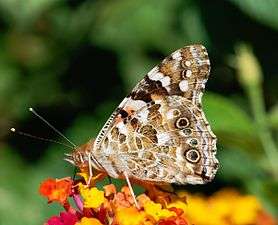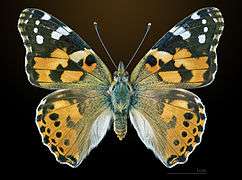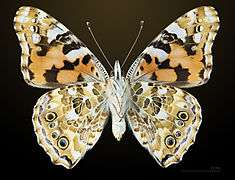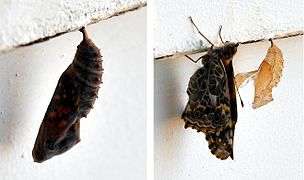Vanessa cardui
| Vanessa cardui | |
|---|---|
_-_Echinacea_purpurea_-_Havr%C3%A9_(3).jpg) | |
| Upperside | |
 | |
| Underside | |
| Scientific classification | |
| Kingdom: | Animalia |
| Phylum: | Arthropoda |
| Class: | Insecta |
| Order: | Lepidoptera |
| Family: | Nymphalidae |
| Genus: | Vanessa |
| Subgenus: | Cynthia |
| Species: | V. cardui |
| Binomial name | |
| Vanessa cardui | |
| Synonyms | |
| |
Vanessa cardui is a well-known colorful butterfly, known as the painted lady,[1][2] or in North America as the cosmopolitan.[3][4]
Description
Male and female. Upperside. Ground-colour reddish-ochreous, basal areas olivescent-ochreous-brown; cilia black, alternated with white, Forewing with an outwardly-oblique black irregular-shaped broken band crossing from middle of the cell to the disc above the submedian vein; the apical area from end of cell and the exterior border also black; before the apex is a short white outwardly-oblique streak and a curved row of four round spots, the second and third being small; a marginal pale lunular line with its upper portion most defined and whitish. Hind-wing with a blackish patch from the costal vein across end of cell, a partly confluent recurved discal band, a submarginal row of lunules, and then a marginal row of somewhat scutiform spots; between the discal band and submarginal lunules is a row of five round black spots, which in some examples show a pale and dark outer ring. Underside. Forewing brighter reddish-ochreous, the apical area and outer margin much paler, the apex being olivescent ochreous-brown; discal irregular band as above, subapical white streak, row of spots and marginal lunules distinct; base of wing and interspace before end of cell white. Hindwing transversely-marbled with olivescent ochreous-brown and speckled with black scales; crossed by basal and discal sinuous whitish or pale fascia and intersected by white veins; an outer-discal row of five ocelli, the upper one smallest and usually imperfect, the second and fifth the largest, the fourth with black centre speckled with blue and ringed with yellow, and the second and fifth also with an outer black ring; submarginal lunules purpurescent-grey, bordered by a whitish fascia; outer margin ochreous. Body olivescent ochreous-brown, abdomen with ochreous bands; palpi blackish above, white beneath; body beneath and legs greyish-white; antennae black above, tip and beneath reddish.
 Dorsal side
Dorsal side Ventral side
Ventral side.jpg) Egg
Egg.jpg) Larva
Larva.jpg) Pupa
Pupa Emergence
Emergence
Distribution
V. cardui is one of the most widespread of all butterflies, found on every continent except Antarctica and South America.[1][2][5] In Australia, V. cardui has a limited range around Bunbury, Fremantle, and Rottnest Island. However, its close relative, the Australian painted lady (V. kershawi, sometimes considered a subspecies) ranges over half the continent. Other closely related species are the American painted lady (V. virginiensis) and the West Coast lady (V. annabella).
Migration
V. cardui occurs in any temperate zone, including mountains in the tropics. The species is resident only in warmer areas, but migrates in spring, and sometimes again in autumn. It migrates from North Africa and the Mediterranean to Britain in May and June, but for decades, naturalists have debated whether the offspring of these immigrants ever make a southwards return migration.[6] Research suggests that British painted ladies do undertake an autumn migration, making a 9,000-mile (14,000 km) round trip from tropical Africa to the Arctic Circle in a series of steps by up to six successive generations.[6] The Radar Entomology Unit at Rothamsted Research provided evidence that autumn migrations take place at high altitude, which explains why these migrations are seldom witnessed.[6]
V. cardui is known for its distinct migratory behavior. In California, they are usually seen flying from north to northwest. These migrations appear to be partially initiated by heavy winter rains in the desert where rainfall controls the growth of larval food plants.[7] Painted lady migration patterns are highly erratic and they do not migrate every year.[8] Some evidence suggests that global climatic events, such as el Niño, may affect the migratory behavior of the painted lady butterflies, causing large-scale migrations.[9]
Based on experimental data, the painted lady's migration pattern in northern Europe apparently does not follow a strict northwest heading. The range of headings suggests that migrating butterflies may adjust their migration patterns in response to local topographical features and weather, such as strong wind patterns. Laboratory-raised autumn-generation painted lady butterflies were able to distinguish a southern orientation for a return migration path. According to the same laboratory-based study, when butterflies were isolated from the sun, they were unable to orient themselves in a specific direction, opposed to those that did have access to the sun. This suggests that V. cardui requires a direct view of the sky, implying the use of a solar compass to orient its migratory direction and maintain a straight flight path.[10]
Mating behavior in relation to migration
V. cardui displays a unique system of continuous mating, throughout all seasons, including the winter. This may be attributed to its migratory patterns, thus significantly affecting its mating behavior. During European migrations, the butterflies immediately begin to mate and lay eggs upon arrival in the Mediterranean in the spring, starting in late May.[11] In the United States, painted lady butterflies migrating towards the north experience poor mating conditions, and many butterflies have limited breeding capabilities.[12] The "local adult generation" develops during this time, roughly from the middle of May through early June in conjunction with the butterfly progression throughout their flight.[11]
During its migratory process, these painted lady butterflies start breeding, and reproduce entirely throughout their migration.[13] Scientists have not been able to find evidence of their overwintering; this may be because they migrate to warmer locations to survive and reproduce.[12] Female painted lady butterflies may suspend their flight temporarily when they are "ready to oviposit";[14] this allows them the opportunity to continually reproduce throughout their migrations. Because these butterflies are constantly migrating, male butterflies are thought to lack consistent territory. Instead of requiring territory to mate with females and developing evolutionary behavior to defend this territory, the mating butterflies appear to establish a particular "time and place" in certain locations that they find to be suitable for reproduction. More specifically, they locate certain perches, hilltops, forest-meadow edges, or other landmarks where they will stay until, presumably, a female to mate.
Equally important for the reproduction of the painted lady butterflies is the males' exhibition of polygynous mating behavior, in which they often mate with more than one female.[15] This is important for painted lady butterflies because the benefits may supersede the costs of polygyny[16] since no permanent breeding ground is used. Upon mating, which typically occurs in the afternoon, female painted lady butterflies lay eggs one by one in their desired breeding locations. The variety of eclosion locations ultimately dictates the male painted lady behavior.[17]
Female painted lady butterflies have been observed to have a relatively "high biotic potential", meaning they each produce large numbers of offspring. This perpetual influx of reproduction may be a reason why these painted lady butterflies have propagated so successfully. One interesting aspect that scientists have observed is that these butterflies like to fly towards rain. Further studies have suggested that the large amounts of rainfall may somehow "activate more eggs or induce better larval development".[18] Inhabited locations begin to observe a large influx of new generations of painted lady butterflies in the fall, particularly in September and October. Their reproductive success declines relatively throughout the winter, primarily through November.[11] However, they still continue to reproduce—an aspect of butterfly behavior that is quite unique. Scientists hypothesize that these extensive migratory patterns help the painted lady butterflies find suitable conditions for breeding, thus offering a possible reason as to why these butterflies mate continuously.
Oviposition
Adult butterflies feed on flower nectar and aphid honeydew.[19] Females oviposit on plants with nectar immediately available for the adults even if it leads to high mortality of the larvae. This lack of discrimination indicates they do not take into account volatile chemicals released from potential host plants when searching for oviposition choices.[20]
The availability of adult resources dictates preference for specific areas of flowers. Flowers with more available nectar result in a larger number of eggs deposited on the plants. This reinforces the idea that the painted lady butterfly does not discriminate host plants and chooses mainly on availability of adult food sources even if it increases mortality rate of the offspring. The data also suggest that the painted lady butterfly favors quantity of offspring over quality.[21]
Roosting behavior and territory
Groups of two to eight painted lady butterflies have been observed to fly in circles around each other for about one to five seconds before separating, symbolizing courtship. Groups of butterflies usually will not fly more than 4.5 m away from the starting point.[22] To establish and defend their territories, adult males perch in the late afternoon in areas where females are most likely to appear.[23] Once the male spots a female of the same species, he begins pursuit of her. If the foreign butterfly is a male, the original male will give chase, flying vertically for a few feet before returning to his perch.[24]
V. cardui establishes territories within areas sheltered by hedgerows.[25] Vanessa cardui tend to inhabit sunny, brightly lit, open environments and are often attracted to open areas of flowers and clovers.[23] Adults spend time in small depressions in the ground on overcast days.[25]
Host plants
Larvae feed on Asteraceae species, including Cirsium, Carduus, Centaurea, Arctium, Onopordum, Helianthus, and Artemisia.[26][27]
The painted lady uses over 300 recorded host plants according to the HOSTS database.[28]
Defense mechanisms
The main defense mechanisms of the painted lady butterflies include flight and camouflage. The caterpillars hide in small silk nests on top of leaves from main predators that include wasps, spiders, ants, and birds.[23]
Human interaction
Vanessa cardui and other painted lady butterflies are bred in schools for educational purposes and used for butterfly releases at hospices, memorial events and weddings.[29]
See also
References
- 1 2 Varshney, R.K.; Smetacek, Peter (2015). A Synoptic Catalogue of the Butterflies of India. New Delhi: Butterfly Research Centre, Bhimtal & Indinov Publishing. p. 219. doi:10.13140/RG.2.1.3966.2164. ISBN 978-81-929826-4-9.
- 1 2 Savela, Markku. "Vanessa cardui (Linnaeus, 1758)". Lepidoptera and Some Other Life Forms. Retrieved July 3, 2018.
- ↑

- 1 2

- ↑ "Painted Lady". A-Z of Butterflies. Butterfly Conservation. Archived from the original on 22 October 2012. Retrieved 22 October 2012.
- 1 2 3 "Butterfly Conservation: Secrets of Painted Lady migration unveiled". BirdGuides Ltd. Retrieved 22 October 2012.
- ↑ Orsak, L. J. (1977). The Butterflies of Orange County, California. Center for Pathobiology Miscellaneous Publication #3. University of CaliforniaPress, New York. 349pp.
- ↑ Larsen, T.B. 1984. Butterflies of Saudi Arabia and Its Neighbours. Stacey International, London, 160 pp.
- ↑ Tilden, J.W. 1962. General characteristics of the movements of Vanessa cardui (L.). Journal of Research on the Lepidoptera 1: 43-49.
- ↑ Nesbit, R.L., J.K. Hill, I.P. Woiwod, D. Sivell, K.J. Bensusan, and J.W. Chapman. "Seasonally Adaptive Migratory Headings Mediated By A Sun Compass In The Painted Lady Butterfly, Vanessa cardui. Animal Behaviour 78 (2009): 1119-1125. Print.
- 1 2 3 Stefanescu, C., Páramo, F., Åkesson, S., Alarcón, M., Ávila, A., Brereton, T., Carnicer, J., Cassar, L. F., Fox, R., Heliölä, J., Hill, J. K., Hirneisen, N., Kjellén, N., Kühn, E., Kuussaari, M., Leskinen, M., Liechti, F., Musche, M., Regan, E. C., Reynolds, D. R., Roy, D. B., Ryrholm, N., Schmaljohann, H., Settele, J., Thomas, C. D., van Swaay, C. and Chapman, J. W. (2012), Multi-generational long-distance migration of insects: studying the painted lady butterfly in the Western Palaearctic. Ecography. doi: 10.1111/j.1600-0587.2012.07738.x
- 1 2 Shapiro, Art. "Vanessa cardui". Art Shapiro's Butterfly Site. Information Center for the Environment (ICE). Retrieved 25 September 2013.
- ↑ Vandenbosch, R. (2003), Fluctuations of Vanessa cardui butterfly abundance with El Niño and Pacific Decadal Oscillation climatic variables. Global Change Biology, 9: 785–790. doi: 10.1046/j.1365-2486.2003.00621.x
- ↑ Tilden, J. W. (1962). "General Characteristics of the Movements of Vanessa cardui (L.)" Journal of Research on the Lepidoptera 43-49
- ↑ Harris, Marie. "Vanessa cardui". Animal Diversity Web. University of Michigan Museum of Zoology. Retrieved 25 September 2013.
- ↑ Davies, N., Krebs, J., & West, S. (2012). An introduction to behavioral ecology. (4th ed.). West Sussex, UK: Wiley-Blackwell.
- ↑ Rutowski, Ronald L. (1991). "The Evolution of Male Mate-Locating Behavior in Butterflies". The American Naturalist Vol. 138, No. 5: 1121-1139.
- ↑ Abbott, Charles H. (1951). "A Quantitative Study of the Migration of the Painted Lady Butterfly, Vanessa cardui L." Ecology Vol. 32, No. 2: 155-171.
- ↑ Scott, J. A. 1986. The butterflies of North America. Stanford University Press.
- ↑ O'Neill, Bridget F., Arthur R. Zangerl, Evan H. Delucia, and May R. Berenbaum. "Olfactory Preferences Of, AndforGrown Under Elevated CO." Environmental Entomology 39.4 (2010): 1291-1301. Print.
- ↑ Janz, Niklas. "The Relationship Between Habitat Selection And Preference For Adult And Larval Food Resources In The Polyphagous Butterfly Vanessa cardui (Lepidoptera: Nymphalidae)". Journal of Insect Behavior 18.6 (2005): 767-780. Print.
- ↑ Hardesty, Richard. "Roosting Behavior in Adult Vanessa cardui" Journal of the Lepidopterists' Society 41.2 (1987): 116-117
- 1 2 3 Harris, M. 1999. "Vanessa cardui" (On-line), Animal Diversity Web. Accessed September 16, 2013 at http://animaldiversity.ummz.umich.edu/accounts/Vanessa_cardui/
- ↑ "Behaviors to Watch." University of Minnesota Extension. Regents of the University of Minnesota, n.d. Web. 16 Sept. 2013. < http://www.extension.umn.edu/distribution/horticulture/components/DG6711d.html>
- 1 2 Hoskins, Adrian. "Butterflies of Europe - Vanessa cardui". learnaboutbutterflies.com. N.p., n.d. Web. 16 September 2013. <http://www.learnaboutbutterflies.com/Britain%20-%20Vanessa%20cardui.htm>.
- ↑ "Painted Lady". A-Z of Butterflies. Butterfly Conservation. Archived from the original on 22 October 2012. Retrieved 22 October 2012.
- ↑ Vanessa cardui, Butterflies of Canada
- ↑ "Vanessa cardui". HOSTS - a Database of the World's Lepidopteran Hostplants. The Natural History Museum. Retrieved 22 October 2012.
- ↑ "Live butterfly release for special events". Cloverlawn Butterflies Farm. Retrieved 15 January 2016.
Further reading
- Opler, Paul A.; Wright, Amy Bartlett (1999). A Field Guide to Western Butterflies. Peterson Field Guides. Boston: Holt McDougal. ISBN 978-0-547-35114-8.
- Chapman, Jason W.; Nesbit, Rebecca L.; Burgin, Laura E.; Reynolds, Don R.; Smith, Alan D.; Middleton, Douglas R.; Hill, Jane K. (2010). "Flight Orientation Behaviors Promote Optimal Migration Trajectories in High-Flying Insects". Science. 327 (5966): 682–5. doi:10.1126/science.1182990. PMID 20133570.
- Nesbit, R.L.; Hill, J.K.; Woiwod, I.P.; Sivell, D.; Bensusan, K.J.; Chapman, J.W. (2009). "Seasonally adaptive migratory headings mediated by a sun compass in the painted lady butterfly, Vanessa cardui". Animal Behaviour. 78 (5): 1119–25. doi:10.1016/j.anbehav.2009.07.039.
- Bolotov I.N. 2012. The Fauna and Ecology of Butterflies (Lepidoptera, Rhopalocera) of the Kanin Peninsula and Kolguev Island. - Entomological Review 92(3): 296-304. DOI 10.1134/S0013873812030062
- Bolotov I.N. 2004. Long-Term Changes in the Fauna of Diurnal Lepidopterans (Lepidoptera, Diurna) in the Northern Taiga Subzone of the Western Russian Plain. Russian Journal of Ecology 35(2): 117–123. DOI 10.1023/B:RUSE.0000018937.44836.c6
External links
| Wikimedia Commons has media related to Vanessa cardui. |